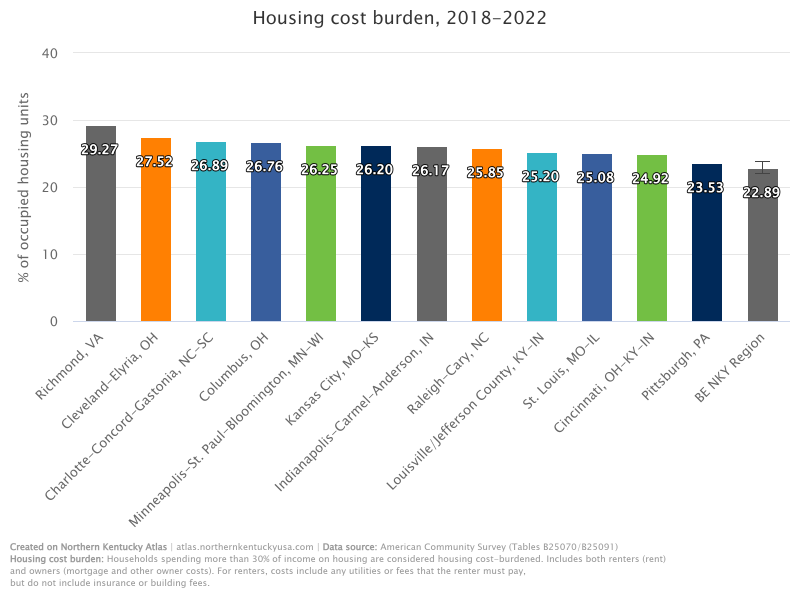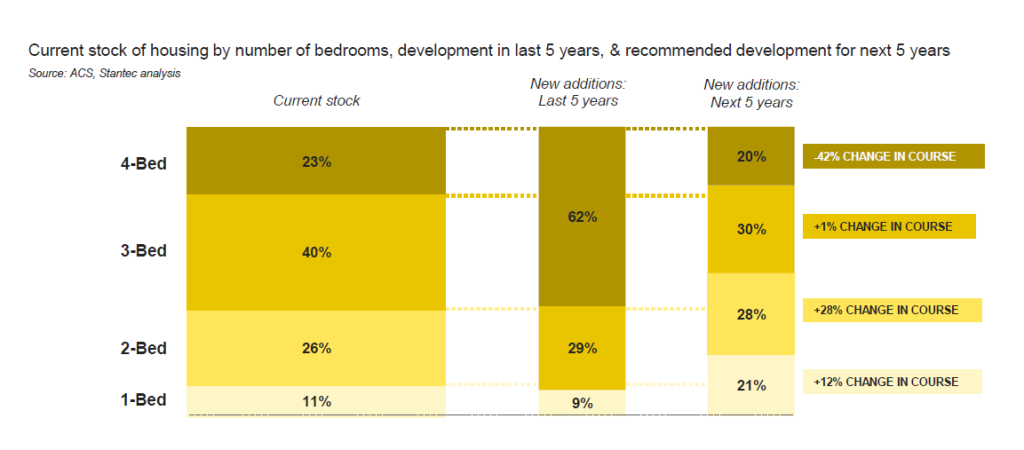
FORT MITCHELL, Ky. — Housing availability and affordability are increasingly intertwined with the future economic success of a region. And like many communities throughout the United States, Northern Kentucky is feeling the effects of a labor shortage. Accordingly, developing strategies that drive talent attraction, promote the region as a desirable place for people to move to, while also working to increase company retention rates are critical to grow the region’s economy.
A lack of available income-aligned housing will make these desired results difficult to achieve. Our region will be challenged to attract new workers and businesses if potential employees and current residents are unable to afford quality housing.
The most recent American Community Survey five-year estimates show that nearly one in four Northern Kentucky households are considered housing cost burdened. The U.S. Department of Housing and Urban Development defines cost-burdened households as those paying more than 30 percent of their gross income toward housing costs, including utilities. Further, rising housing costs are both a contributor to, as well as an outcome of, the increasing inflation we have experienced over the last two years.
Prospective companies recognize the need for adequate housing to maintain a thriving workforce. According to the 2024 Site Selectors Survey by Site Selection Magazine, income-aligned housing is a top 10 location factor for companies in the site selection process.
As the economic development company for Boone, Campbell, and Kenton counties, BE NKY Growth Partnership (BE NKY) and our data-informed advisory council are focused on Northern Kentucky’s economic competitiveness, of which income-aligned housing is a key component. As companies are looking to make investment and site decisions for locating their operations, housing, and overall quality of life is “top of mind.” Together with many community organizations, we are shining a light on these housing issues.
NKADD Housing Data Analysis
In 2023, the eight fiscal courts within the Northern Kentucky Area Development District (NKADD), with the Cincinnati/Northern Kentucky International Airport, published a comprehensive housing study conducted by a third-party consultant that provides a detailed assessment of current and projected housing inventory relative to demand, cost, and relationship to economic conditions and jobs. Using this information, a gap analysis identified the types of housing by price point that will be needed going forward.
The study found that in the three counties served by BE NKY, workforce job creation is outpacing workforce housing. Specifically, there are 2.68 workforce jobs for each housing unit these jobs could afford. Workforce jobs, defined in the study as those earning below $60,000 per year, make up about 60 percent of occupations in the overall NKADD region. While people typically think of workforce jobs as being lower skilled or entry level, this also encompasses essential occupations such as teachers, nurses, police officers, and firefighters.
A lack of income-aligned housing for jobs being created will make it harder and more expensive for employers to find and recruit labor at prevailing market wages, according to the study, and an inadequate housing stock can lead to decreased quality of life for families who must choose between shorter commutes and lower housing costs.
Strategies and solutions
The study estimates the eight-county NKADD region has a five-year housing production need of 6,650 units, or about 1,330 per year, to support economic development. On the surface, this is slower than the current pace of development in Boone, Kenton, and Campbell counties, which have averaged almost 1,600 residential units permitted annually over the last five years. That said, of the 6,650 units, half should be tailored toward residents making up to 60 percent of the area median household income of $103,600. The region’s residential development must also offset existing housing units that are being taken offline, through factors such as conversions of multi-family to single-family, vacation rentals, and the demolition of obsolete units.
To adequately address demand, new housing should reflect demographic trends toward smaller and older households by offering more one-and-two-bedroom units, accounting for about 4,220 units of the new production. This will give both younger, newly established households and older adults a place in the market, freeing up some of the demand for larger three-to-four-bedroom homes.

Multi-unit buildings in areas that are walkable or connected to job hubs will help fill the “missing middle” in housing stock in our region. These developments would better account for a diversity of incomes and smaller household sizes.
Today, there are existing programs that seek to increase the number of homeowners though homebuyer assistance, notably the HOME program administered by the Northern Kentucky HOME Consortium offered in Bellevue, Covington, Dayton, Erlanger, Florence, Ludlow, and Newport. Under this program, households which meet income, credit, and other requirements may obtain zero-interest, deferred/forgivable loans to assist with purchasing an owner-occupied home. The loans can be used to cover lender required down payment, customary closing costs, and settlement charges.
Ultimately, there are a number of strategies that merit consideration, and it is likely that there is not a “one-size-fits-all” solution for the region’s housing challenges. At the same time, this is not an either/or proposition, as a focus on income-aligned housing does not preclude the region from building single-family homes.
As a next step, various stakeholders in the public, private, and non-profit sectors will collaborate with the goal of identifying targeted actions to apply to the housing challenge. Recommendations from the study will be considered with the aim that these findings will help align and inform policy.
Using data analysis to drive regional strategy
BE NKY Growth Partnership established four initiatives, including data-informed community decision-making, as part of our 2022 Build + Elevate NKY Investor Campaign.
At BE NKY, we want to enable Northern Kentucky’s business and community leaders to contribute to growth in our region by providing them with data, insights, and a forum to inform better decision-making and address community challenges.
Housing affordability is just one of four focus areas for BE NKY. In future articles, we will dive into population/labor force growth, early childhood development/third grade reading, and access to transportation.
David McAleese is Research Director at BE NKY Growth Partnership. Through BE NKY’s Build + Elevate NKY campaign, McAleese leads the “Data-Informed Community Decision-Making” initiative, one of four developed by BE NKY to continue work toward increased community prosperity.



















